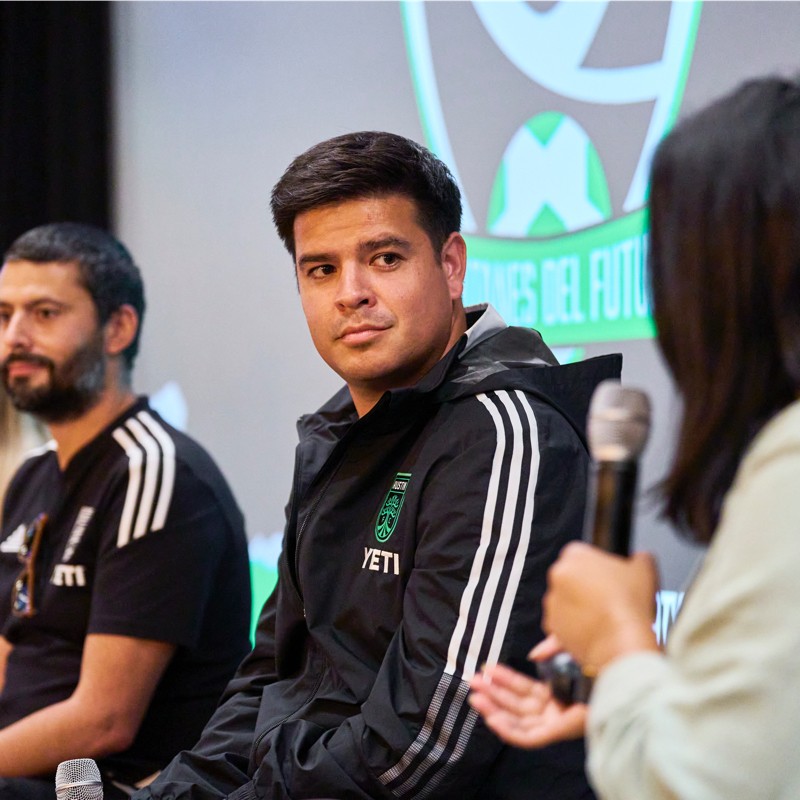03.06.24Memo Sifuentes’ Halftime Framework for Young Athletes

Memo Sifuentes
Memo Sifuentes coaches the u14s (and formerly the u12s) at Austin FC’s Youth Academy. I always find him incredibly thoughtful and intentional about the teaching part of his job.
We’ve been talking a bit over the past year about game day coaching: what to do to maximize long-term learning at halftime, in pregame talks, during the match, and afterwards.
After one of our discussions, Memo put together a ‘framework’ so there was a clear model for how things were supposed to go at halftime with his team.
I’ve outlined it, and a few of Memo’s reflections, below.
The Framework
At half time Memo’s goal is to the limit the amount of feedback players receive to manageable amounts and to delegate clear roles and responsibilities among coaches.
1. Half ends: Players getting water. Coaching staff goal: “touch every player” i.e. make them feel connected, important, supported: high five, hand on shoulder, hand shake. Divided among coaches and staff so we get to everyone.
2. Head and assistant (and other present staff) meet for 3-4 minutes.
- “Intentionally regulate each other emotionally so we are prepared to talk to players.”
- Share notes and observations among coaches/staff
- Decide three priority coaching points to be shared with team. [“Usually it’s 1 attacking, one defending, and one lineup/tactical change but it also might be 2 attacking and one defending point 4) decide who will have responsibility to discuss each point with team [“Usually I do attack and my assistant does defending but but not always”].
- Decide together what tone we want to strike with team and what root value we want to couch it in. eg “collective” mentality. Think about the people who support you to make your success possible.
3. While coaches are meeting players in groups talking about their play – With the Under 12s, we generally divided the players into 2 groups. One group consisting of back 5 and the other of the front 5. Goalkeepers would typically join the back 5. (U12 is 9v9 and we would play 1-4-3-1) Substitutes would join the group the position they were assigned for that game. We would ask the groups to discuss and rate a game principle to help guide the player discussion.
4. Circle up. Coaches deliver three key teaching points.
5. End with “common focal point”: one clear thing we want to try to do during the first five minutes of the second half. E.g. We want ten shots; When we build let’s try to play to the right center back first…. It’s more actionable and focused and less controlling to try to shape it for just five minutes, gives players a clear goal to change behavior but then autonomy to adapt. Staff’s coaching style is dependent on if the focal point has been trained or if the focal point is ‘new’ to the team. For example, established and familiar focal point=more questioning and guided discovery; less familiar more directive.
Questions for Memo:
How’s the routine changed over time?
It felt a bit forced at first. You’re building a habit of self-discipline. It’s hard. You have to be aware of why you’re doing it. But it’s helpful and also creates a habit for the players, including their “walk to the locker room” as they self-regulate and discuss the first half. For staff, it creates important roles and responsibilities.
Can you give an example of self-regulating.
Against FC Dallas there was a yellow card to one of our players. The ref had been really inconsistent, and we got a little too caught up in it. We reminded ourselves: Focus on what we control. Control the controllables. If we focus on the ref so will the players.
When is it most challenging?
Tournaments, especially. During the season, it’s typically my assistant, S&C staff member or trainer, and at times our GK coach. During tournaments, staff increases and everyone is there to help and so they want to share their thoughts. It’s all good information but it would be too much for the kids to process. So in this case the assistant circulates five minutes before half to gather everyone’s feedback. That way we make sure the staff meeting during half time stays within those 3-4 minutes and players get manageable loads of feedback.
